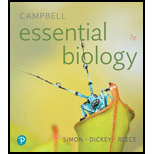
Concept explainers
Which is not a characteristic of all living organisms?
- a. growth and development
- b. composed of multiple cells
- c. complex yet organized
- d. uses energy
Introduction:
To characterize an organism as living, it must perform certain functions like growth and development, carry out different metabolic processes like respiration, digestion, excretion and more, and also it must reproduce and carry out functions essential for life.
Answer to Problem 1SQ
Correct answer:
All the living organisms are not multicellular. Rather, the majority of living beings are unicellular. Therefore, option b is correct.
Explanation of Solution
Reason for the correct statement:
Life on Earth started as a single cell. Over a period of billions of years, these unicellular organisms gave rise to multicellular beings. However, this advent of multi-cellular organisms did not cease the existence of unicellular organisms. Moreover, two of the five kingdoms are completely composed of unicellular organisms (monera prokaryotes. and protista eukaryotes). Single-celled organisms are present in other kingdoms too.
Option b is given as “composed of multiple cells”.
As “being a multicellular organism is not an essential characteristic of life,” it is the right answer.
Hence, option b is correct.
Reasons for the incorrect statements:
Option a is given as “growth and development”.
All organisms grow and develop. It is the elementary purpose of life. Thus, it is a characteristic of life seen in all organisms. So, it is a wrong answer.
Option c is given as “complex yet organized”.
Though a lot of organisms are primitive like the bacteria, they still are organized and complex. Thus, it is a life characteristic of all the organisms. So, it is a wrong answer.
Option d. is given as “uses energy”.
All living organisms perform metabolic processes to survive for which they have to utilize energy. Thus, this is a characteristic of life seen in all the living beings. So, it is wrong answer.
Hence, options a., c. and d. are incorrect.
Multicellularity is not a characteristic of life evident in all the organisms. Most of the organisms on Earth are unicellular and thus they can sustain life with just a single cell.
Want to see more full solutions like this?
Chapter 1 Solutions
Campbell Essential Biology (7th Edition)
Additional Science Textbook Solutions
Biological Science (6th Edition)
Laboratory Manual For Human Anatomy & Physiology
SEELEY'S ANATOMY+PHYSIOLOGY
Biology: Life on Earth with Physiology (11th Edition)
HUMAN ANATOMY
Campbell Essential Biology (7th Edition)
- What is behavioral adaptarrow_forward22. Which of the following mutant proteins is expected to have a dominant negative effect when over- expressed in normal cells? a. mutant PI3-kinase that lacks the SH2 domain but retains the kinase function b. mutant Grb2 protein that cannot bind to RTK c. mutant RTK that lacks the extracellular domain d. mutant PDK that has the PH domain but lost the kinase function e. all of the abovearrow_forwardWhat is the label ?arrow_forward
- Can you described the image? Can you explain the question as well their answer and how to get to an answer to an problem like this?arrow_forwardglg 112 mid unit assignment Identifying melting processesarrow_forwardGive only the mode of inheritance consistent with all three pedigrees and only two reasons that support this, nothing more, (it shouldn't take too long)arrow_forward
- Oarrow_forwardDescribe the principle of homeostasis.arrow_forwardExplain how the hormones of the glands listed below travel around the body to target organs and tissues : Pituitary gland Hypothalamus Thyroid Parathyroid Adrenal Pineal Pancreas(islets of langerhans) Gonads (testes and ovaries) Placentaarrow_forward
 Concepts of BiologyBiologyISBN:9781938168116Author:Samantha Fowler, Rebecca Roush, James WisePublisher:OpenStax College
Concepts of BiologyBiologyISBN:9781938168116Author:Samantha Fowler, Rebecca Roush, James WisePublisher:OpenStax College Biology (MindTap Course List)BiologyISBN:9781337392938Author:Eldra Solomon, Charles Martin, Diana W. Martin, Linda R. BergPublisher:Cengage Learning
Biology (MindTap Course List)BiologyISBN:9781337392938Author:Eldra Solomon, Charles Martin, Diana W. Martin, Linda R. BergPublisher:Cengage Learning Comprehensive Medical Assisting: Administrative a...NursingISBN:9781305964792Author:Wilburta Q. Lindh, Carol D. Tamparo, Barbara M. Dahl, Julie Morris, Cindy CorreaPublisher:Cengage Learning
Comprehensive Medical Assisting: Administrative a...NursingISBN:9781305964792Author:Wilburta Q. Lindh, Carol D. Tamparo, Barbara M. Dahl, Julie Morris, Cindy CorreaPublisher:Cengage Learning- Essentials Health Info Management Principles/Prac...Health & NutritionISBN:9780357191651Author:BowiePublisher:Cengage
 Human Biology (MindTap Course List)BiologyISBN:9781305112100Author:Cecie Starr, Beverly McMillanPublisher:Cengage Learning
Human Biology (MindTap Course List)BiologyISBN:9781305112100Author:Cecie Starr, Beverly McMillanPublisher:Cengage Learning





